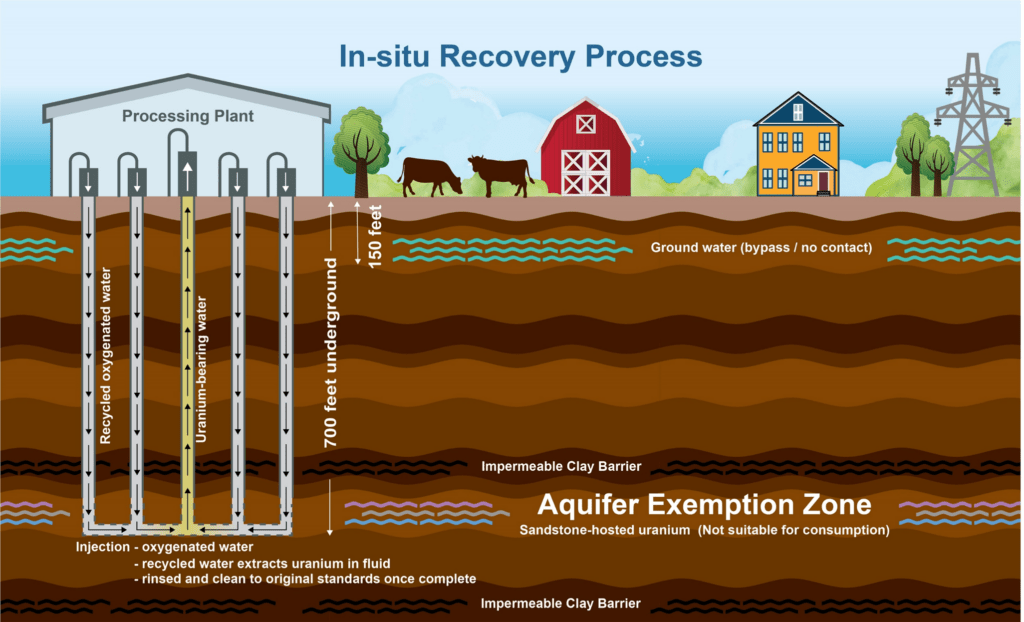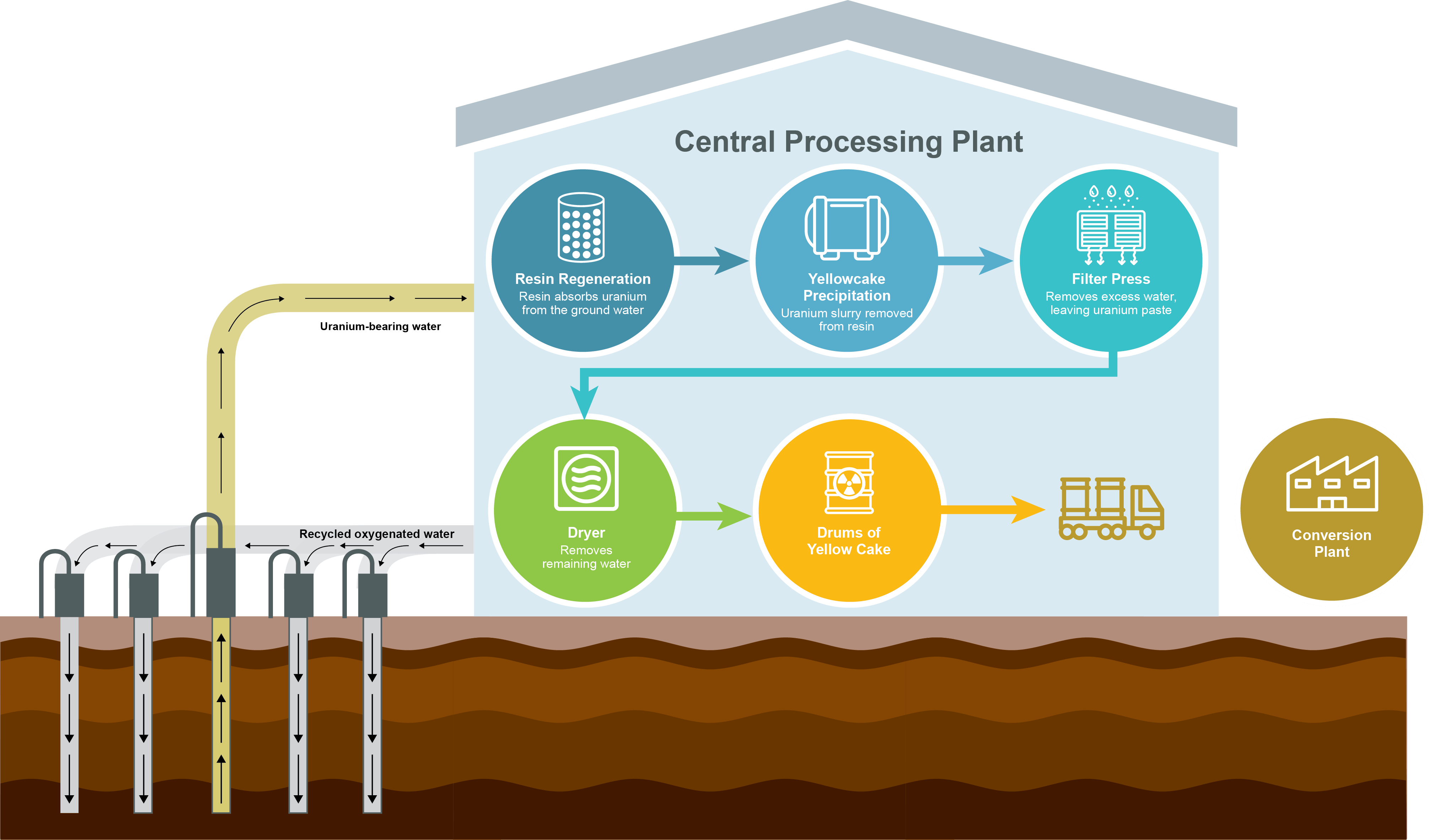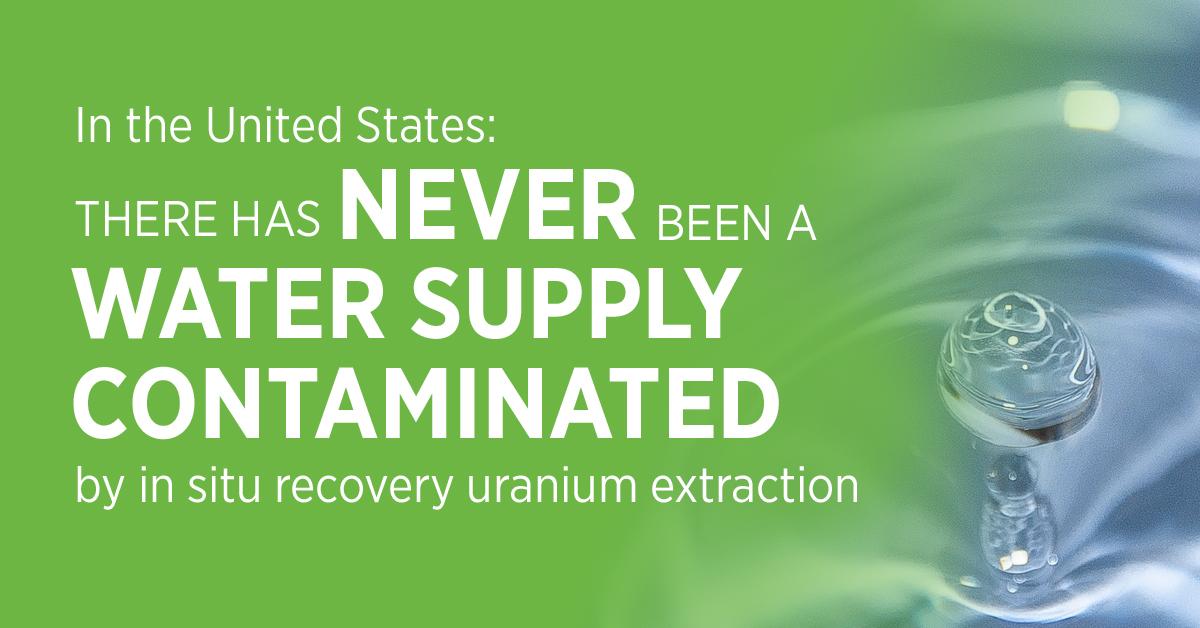In-Situ Recovery (ISR)
What is In Situ Recovery (ISR)?
In-Situ Recovery (ISR) is a minimally invasive, environmentally friendly, and economically competitive way of extracting minerals from the ground. It has proven to be a successful method of extracting uranium and due to its cost efficiency, is economically viable to extract lower grade uranium deposits that may not justify the cost of conventional open pit or underground mining. In addition to significantly lower capital and operating costs, ISR operates without the open pits, waste dumps, or tailings associated with conventional mining and milling, making extraction more environmentally responsible while also resulting in a faster and more costefficient permitting, development and remediation process. ISR extraction is able to extract the uranium while leaving the surface intact, and when reclamation is completed, it is returned to its original state and use.
Since its first appearance in the 1960s, ISR technology has progressed considerably to the point where the process is a controllable, safe, and benign method of uranium production that is heavily regulated in the United States. ISR now accounts for approximately 70% of all the uranium produced worldwide. While some countries, such as Kazakhstan and Australia, still use harsh chemicals like sulfuric acid to remove the uranium from the ore body. In the United States, many companies will use a lixiviant that is a combination of oxygen and sodium bicarbonate in the native groundwater, extracting uranium at a near neutral pH and significantly less environmental impacts.

ISR was commercially introduced in the uranium sector during the 1970s in the USA, and then applied in many countries over the last 50 years.
enCore Energy’s Director, Dennis Stover, PhD, was awarded several of the first ISR patents in the United States and was instrumental in the technology.
ISR allows the extraction of minerals leaving the host rocks ‘in place’. No waste piles , haul trucks, tailings or long term disturbance.
How does it work?
In-Situ Recovery (ISR) is a mineral extraction technology which injects a water-based lixiviant solution into the ground to extract minerals from the earth without conventional mining techniques and minimal use of groundwater.
ISR uranium extraction usually takes place in sandstone deposits, within a portion of the aquifer that the government has exempted from protection as an underground source of drinking water due to its mineral content preventing its use as a source of drinking water, such as uranium, radium, and other minerals. An ISR wellfield is developed using a series of production patterns that are made up of a series of injection and recovery wells. The injection well introduces the lixiviant, made up with native groundwater that is fortified with oxygen and sodium bicarbonate, to the uranium bearing sandstone. As the lixiviant is injected through the uranium bearing sandstone, the uranium is solubilized by the oxygen in the lixiviant, and the uranium-bearing lixiviant is carried through the sandstone to the recovery well. Recovery wells pump the mineral-carrying solution back to the surface where it is taken to a processing facility to be separated and ultimately, becomes U3O8, or yellowcake. ISR has been safely used around the world for over 50 years with minimal environmental impact. Once an ISR operation is complete, the groundwater and land are restored to their previous condition and use categories.
A multiple jurisdictional state and federal regulatory regime ensures that no solution escapes from the ISR area and ground water is protected.
According to the U.S. Nuclear Regulatory Commission there has never been a drinking water supply contaminated by ISR in the 50 years since its inception.
ISR facilities use less water than conventional mining and return 99% of water used to the aquifer (not used for drinking water or livestock).


Frequently Asked Questions
Will uranium extraction contaminate the drinking water/groundwater?
Uranium is already in the underground aquifer, which is why the Environmental Protection Agency has deemed it contaminated and not suitable for drinking water for humans or animals. This groundwater flows through sediments mineralized with uranium. ISR will remove much of this contaminate. Commercial scale In-Situ Recovery (ISR) uranium extraction has operated in the US for almost 50 years, replacing conventional mining when conditions are appropriate. In these 50 years, no groundwater that has been designated as drinking water quality has been left in a contaminated state after final closure of the uranium extraction operations. Historically, following completion of uranium recovery, these operations have restored the underground aquifer to the same Federal use category it had before extraction began.
The United States Environmental Protection Agency (EPA) reviews every new ISR operation and only authorizes ISR operations in a very specific portion of underground aquifers, which the EPA classifies as contaminated for drinking purposes. Absolutely no activities are allowed outside of this small, designated area. United States Nuclear Regulation Committee (NRC) and State regulations require the company to return the water quality within this area to the same water quality use standards for which it was previously designated. Unlike most water wells, ISR operation wells are cased in heavy duty PVC piping, and once mining operations are complete, are filled with cement, to prevent fluid from entering any other water source or ground interval. During mining operations, groundwater is monitored with electronic and staffed controls as required by regulatory agencies which review the data monthly or quarterly. Any exception must be reported by the operator to these agencies immediately and corrective action immediately implemented.
What guarantees do we have that the projects will be reclaimed and will not leave a mess in operations and after production?
This is not the cold war era of the 1950s and 1960s when environmental cleanup and employee safety at conventional uranium mines were afterthoughts. Licensing of ISR projects requires firm plans for not only development and operations, but also for total reclamation and restoration of both the site and the affected groundwater. It is required to secure and post millions of dollars in bonds with the Environmental Protection Agency and Nuclear Regulatory Commission (NRC) to ensure sound reclamation. Only when the cleanup is approved, will the bonds be returned to the company.
The Nuclear energy industry is the singularly most highly regulated industry in the United States which includes everything from uranium mining to the x-ray in the local hospital. There are no exceptions.
Does In-Situ Recovery (ISR) uranium extraction inject harsh chemicals into the groundwater?
No, in the United States only gaseous oxygen and a bicarbonate is used. This is the equivalent of adding oxygen and baking soda to the contaminated underground aquifer, never touching drinking water. In the contaminated aquifer, the gaseous oxygen and bicarbonate within with water dissolves the uranium minerals which exist as coatings on sand grains. We recover this groundwater, along with the dissolved uranium minerals, to our water treatment plant (similar to a home water softener only much larger) where the uranium is removed. Once the uranium is removed, the remaining water is then recycled and returned to the aquifer. Unlike conventional uranium mills, we do not use any acid to dissolve the uranium as they do in foreign countries. The United States has very high environmental standards.
Are there any reclaimed In-Situ Recovery (ISR) projects in the US?
There are 24 reclaimed uranium ISR projects in the United States.
It is also important to understand that, typically, the reclamation of ISR projects is a continual yet finite process. As a company works to extract uranium, it builds wellfields in specific patterns and then moves along the uranium resources over time as extraction proceeds. The Company then removes (from production) and reclaims exhausted wellfields as it completes the ongoing extraction process, thereby moving from one area to the next.
What is the risk of contamination from radiation at site and when shipping uranium?
The nuclear energy industry is extremely regulated with safety and health regulations in place (including worker safety, air quality, radiation, water quality, spill management and more) that apply not only to on-site facilities but also extend to the transportation of the natural uranium product (yellowcake). Yellowcake is a dry powder. It is sealed in steel containers for transport to a conversion facility where it is transformed into an energy source for domestic and commercial use in the electric grid. It is shipped by tractor-trailer and regulated by the US Department of Transportation with extremely stringent requirements. Yellowcake shipments require advance written notification to the Nuclear Regulatory Commission (NRC) of the planned shipment including the content, quantity, and route to be followed. In addition, only a small number of trucking companies are certified to handle and transport yellowcake.
What is the benefit to the communities? Does all the money flow out of the county and out of the country?
Nuclear Fuels is a North American company and all benefits stay within the United States and Canada.
It is expected that activity from development, operations and reclamation will last many years and will fuel local economies with jobs and strengthen local businesses. It is important that we provide opportunities for our youth to benefit from the extraction activities through jobs, education and training, thereby allowing our communities and families to grow and prosper.
Is In-Situ Recovery (ISR) fracking?
In-situ recovery is not fracking. Fracking utilizes a totally different process than ISR. Fracking opens up preferential “fractures” in the subsurface using extreme pressure in order to provide conduits to extract hydrocarbons. Fracking is not a viable practice for ISR. ISR is designed specifically to avoid opening “cracks” and works by flowing water through existing sediments within an aquifer. Uranium minerals suitable for ISR extraction are deposited as coatings on sand grains and spread across both vertical and horizontal areas of the contaminated underground aquifer. ISR wells are designed to ensure that the water used in injection and extraction flows slowly and consistently through the aquifer in order to contact and dissolve the uranium minerals.

